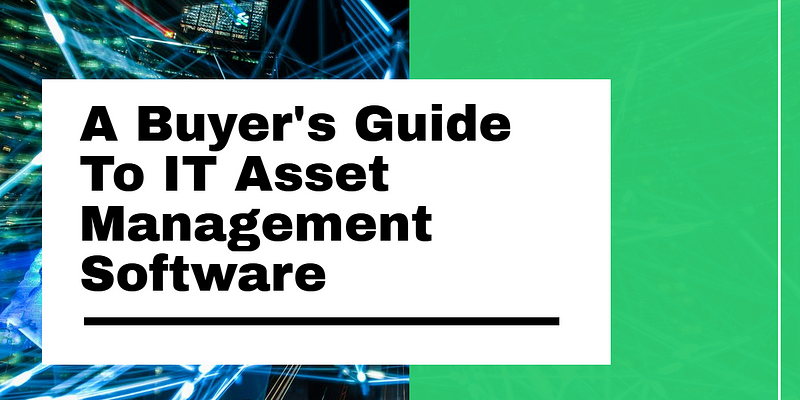Boost business performance: Identifying the need for an automated solution
The proliferation of digital devices can get overwhelming for organizations. Haphazard business strategies make it difficult for employees to access the required information. So, the question is how can you help users locate and access Assets whenever they need them? The answer lies in the streamlined implementation of an IT asset management (ITAM) solution. In basic terms, ITAM overlooks the utilization and lifespan of equipment and ensures that all devices are fit for daily business operations.
By opting for an automated program, companies can save time and effort to retrieve and distribute Assets. However, industries have different data needs, end-user requirements, and even more divergent feature demands. So, before choosing a cloud-based system, organizations should carefully plan and evaluate the current business portfolio.
Here are a few questions to keep in mind while deciding which management solution to opt for:
1. What type of assets do you need to monitor?
Before you divulge in the complicated process of choosing an ITAM vendor, first take a look at the types of assets the company owns. Mainly IT equipment is divided into hardware products and software applications. The role of these assets is to facilitate the collection, transfer, storage, or processing of data.
Some common examples of hardware products include:
- Computers and servers: Assets like laptops, desktops, and tablets are widely used by businesses to share resources and information. With WIFI connectivity and portability, such applications serve multiple functions and contain critical organizational data.
- Peripheral devices: This generally includes keyboards, printers, webcams, projectors, and monitors. While these devices do not contain any critical information, they do help in connecting interfaces.
- Telecommunication infrastructure: Routers, cables, and local networks used for the purpose of internal and external communication fall within this category.
In addition to hardware items, companies also deploy various types of software to run daily operations. The diverse set of assets owned by organizations calls for a multifaceted IT Asset Management with cloud storage.
2. How is your asset content organized?
Accurate information plays a key role in determining the performance level of a business. Companies usually tend to store data in spreadsheets or on-premise software. Manual entry of Asset activities into the server can take a lot of time and is prone to errors.
An ITAM relies on metadata collected by the organization, without which utilizing content can become quite complex. The gap between a scattered and a precisely systematic repository can be bridged. While doing this is possible, it will take some time. When selecting an IT Asset Management software, estimate roughly how long it will take to reorganize the database.
3. Who are the users and how will they utilize the assets?
A company owns hundreds of devices and small tools which are not restricted to any one group or team. There are multiple Users within an organization like researchers, sales department, marketing team, managers, and even customers. The point of concern here is to decide who has what level of access? Should an executive have the same level of leverage as the admin team? Or an entry-level user be allowed to make major changes in the database?
Apart from internal departments, companies should consider how data permissions will impact external parties and customers. Once you decide this, you will be in a better position to choose appropriate software for IT Asset Tracking processes.
4. What features does your organization value?
For various sectors in the market, there are numerous IT solutions available designed to cater to individual demands. Let’s take the example of the education sector. In the age of high-tech devices, most schools own smart tablets, digital textbooks, projectors, and audiovisual equipment. Whereas in the entertainment sector, industries need large servers to support heavy video and media files.
Identifying the main business agenda helps to shortlist the features of a potential IT management solution. From generating higher productivity levels to increasing efficiency, an organization can aim to achieve either or both. Ranking desirable features allow you to narrow your focus and choose reliable IT software.
Read more: Difference between Asset Management and ITAM
How does cloud-based IT asset management software benefit your organization?
A cloud-based ITAM solution is a long-term investment that requires both financial and HR inputs to achieve the desired outcome. While deciding which software you want to deploy, you should understand what to expect from an automated solution. Doing this helps you to analyze the overall performance and gear it towards higher growth possibilities.

Here are a couple of ways ITAM software can help your organization:
- Improved transparency: With login-enabled check-ins and checkouts, a software program allows companies to keep track of Asset utilization at all times. Every department owns a particular set of IT devices that could get mixed up or misplaced if not monitored properly. By tagging all your equipment in the correct manner, you can trace out the usage for all types of business activities.
- Effective time management: Keeping tabs on miscellaneous workflows can get quite tough. For instance, tracking maintenance time for the projector in the AV room or procurement for more hard drives. The absence of a streamlined timeline hinders business performance. But an IT software enables you to map out daily events to eliminate double bookings or early stockouts.
- Software integrations: The majority of cloud-based IT solutions offer integrations with third-party software. This means you don’t have to lose out on critical data stored on other platforms. Companies can also easily import and export data files from the server.
- Performance reports: One way to evaluate the impact of an automated solution is to generate analytical reports. An ITAM software allows you to request Asset performance reviews. Such information enables firms to assess current workflows and make the necessary amendments.
What constitutes streamlined cloud-based IT asset management?
The key to having a successful ITAM solution is to plan, develop and execute business strategies in the correct manner. In order to do so, software programs automate certain tasks to help eliminate inefficiencies.
Here are three fundamental aspects of a cloud-based solution, which allow organizations to run smooth IT workflows:
1. Auto asset discovery
Manual data collection can be time-consuming and prone to errors. For this reason, IT Asset Management software allows you to automatically discover all assets within a specified network or department. This provides an up-to-date inventory base containing all types of hardware and software applications.
The feature works by gathering IT Asset details including system updates, warranty information, and software installation dates. Combining different techniques allows a greater number of Assets to be added to the database and tracked over time. An accurate representation of company-owned resources enables informed decision-making.
2. Lifecycle management
To optimize Asset utilization, it is important to monitor every phase of the Asset Lifecycle. Especially when it comes to IT Assets, where hardware and software both are concerned, companies need to implement a rigorous lifecycle management program. The basic three steps of this program include:
- IT Asset Procurement
- IT Asset Change Management
- Asset Disposal and Replacement
In order to streamline procurement, IT Asset Management software lets you set minimum stock levels. Once this threshold is reached, Purchase Orders are created automatically and Vendors are notified.
The second stage involves the depreciation that hardware Assets go through. To maintain a functional state, the software enables companies to schedule recurring services for all equipment. Lastly, with technological advancement, organizations have to dispose of existing Assets or replace old equipment. This process should not be hasty but well-planned with the aim of maximizing business efficiency.
3. License and warranty tracking
In large enterprises, purchasing and administering IT hardware and software Assets is a complicated procedure. To simplify the workflows, organizations opt for ITAM software that helps in license and warranty tracking.
Working with expired licenses can lead to heavy fines. Whereas, inaccurate software inventory records can hinder compliance with license terms and conditions. To avoid legal penalties, organizations opt for a software program which lets them keep an inventory of all IT Assets. By tracking license usage over time, automated alerts help in timely renewals and terminating any extra purchases.
On the other hand, warranties accompany each and every component of IT Assets. Losing warranties can result in large-scale repair costs. While manual storage of warranties is an option, it’s not a feasible one. As a better alternative, companies rely on ITAM software to record warranties for different products and make them easily accessible at all times. You can even send out notification alerts before expiry dates for warranty renewals so that all devices remain protected.
Before buying a cloud-based IT asset management solution: Define business goals and objectives
With several different software options available in the market, how can you decide which one is the most appropriate for your business? To answer this question, you should have a clear idea of how you want to utilize the software. Without precise goals on the agenda, even the best software cannot do much for your organization.

Let’s define a few key objectives and the relevant metrics companies can keep a track of:
I. If you want to formulate an effective budget, track:
- The average cost of a working station
- The average cost of a license
- The total expenditure on Assets, categorized by vendors
- The total value of IT resources owned by the company
II. If you want to gain license compliance, track:
- The ratio of used to licenses purchased
- Software licenses and respective expiration dates
- Number of licenses available in the company
III. If you want to streamline IT procurement, track:
- The depreciation rate of equipment
- Lease violation fines paid on average
- The average cost of Asset maintenance
- Number of workstations undergoing repair
IV. If you want to eliminate discrepancies, monitor:
- Number of unauthorized items configured
- Assets’ breakdowns leading to service failures
- Audit history
V. If you want to optimize resource utilization, monitor:
- Unassigned workstations
- Users with multiple workstations
- Users without a mapped workstation
Read more: Reasons you need to set business goals
Organizations can choose to focus on one or more goals at the same time. Listing down what you expect to achieve from an ITAM software will help you streamline the procurement process. A strong backup system allows companies to progress and gain operational efficiency.
What factors to consider when buying a cloud-based IT asset management tool?
When it comes to buying a software solution for your business, it is always best to keep long-term goals in mind. Moving all Asset data from one system to another is no easy task, so it is better to select the option which has the capacity to support the organization for a couple of years.
Here are some features which make any software adaptable to different sectors of the industry:
- Customizable to the workflow: Accurate Asset information forms the baseline for all business analytics and reports. For this purpose, the software you choose should offer customization. A tailor-made management platform is quite popular within companies as it helps to store data in different forms. By creating fields for minute details about Assets owned by various departments, you can centralize all critical information. Customized data can be easily be transferred to other platforms.
- Scalability: Hosting data on cloud-based software offers you to grow in response to increased demands. This process is known as scalability and lets you adjust data storage according to business fluctuations. Instead of looking for alternate options, when you want to expand a product line, you can simply add nodes to increase storage space to track Asset-related activities. When the demand dwindles away, you can switch back to the previous storage capacity as well.
- Regular updates: IT Assets evolve and change over time. They get regular upgrades and are frequently replaced. When buying ITAM software, be sure to look out for options that offer timely updates. This lets you improve service performance by staying in line with market demands and tackling competition.
Conclusion
Cloud-based IT asset management is an evolutionary process that starts from choosing the right software for your organization. The first step is to understand the types of Assets utilized by the company. Next comes laying down a few business goals and objectives and selecting the software which allows you to track the relevant metrics.
Effective IT Asset management isn’t just limited to automated Asset tracking, it calls for in-depth performance evaluation and self-assessment. Adopting a proactive approach lets you control Assets and achieve a higher ROI.
AssetSonar is a cloud-based IT asset management software that features a device data agent. It enables companies to track both their hardware and software by putting in place a complete IT asset management system.







